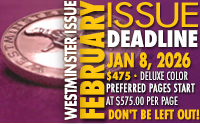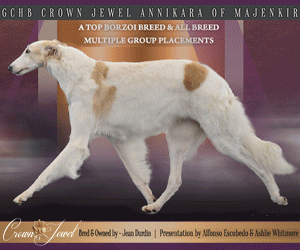Can a Breeder/Owner/Handler Win Westminster?

1940 & 1941 WKC Best In Show Winner - Ch. My Own Brucie
From the archives of The Canine Chronicle, March, 2015
By Amy Fernandez
Only seven breeder/ owner/ handlers and one breeder/ handler, a total of eight, have gone all the way to Best In Show in Westminster’s 138-year history. The club began offering a BIS class in 1907 with a panel of judges choosing the winner. Possibly because it was then a non regular class, neither Westminster nor AKC recognized its significance. American Field was first to promote it as “the dog world’s most coveted honor.”
By 1918, fanciers worldwide fully appreciated the magnitude of a Westminster Best In Show win. And it was a hairsplitting decision that year. The odds-on favorite was the top winning Pekingese, Phantom of Ashcroft. Perhaps, Bull Terrier breeder David Merriam wasn’t the most impartial journalist reporting on that year’s show. But he definitely captured it. Describing the win as “the most cherished prize within the gift of American dogdom”, going on to say “Never was there a more popular BIS award” and calling Haymarket Faultless the “devoted pal of his owner”. Breeder/handled, this two-year-old white dog brought new fame to R.H. Elliott’s Ottawa-based Haymarket kennel. As the breed’s first official AKC BIS winner he also became a focal point of the club’s internecine war about size, type, and color.
While Bull Terrier fanciers hashed out the repercussions of that win, William Payne handled his homebred Cocker bitch to Best In Show in 1921. His Midkiff Kennel in Dallas, Pennsylvania was acknowledged for its quality. Even so, parti-colored Ch. Midkiff Seductive was the long-shot that year.
It was 20 years before another breeder/owner/handler took Best at Westminster, and surprisingly another Cocker broke the losing streak. In 1940, Ch. My Own Brucie catapulted his breed and his breeder, Herman Mellenthin, to mass media adoration. Mellenthin had successfully handled several representatives of his breeding program at Westminster, including Brucie who was BIS American-bred the year before. This time he won Best Am-bred by default. A year later, both Brucie and his breeder were mainstream superstars. Their 1941 Westminster BIS was an unprecedented crowd pleaser and the culmination of Mellenthin’s breeding program. It also earned him an invitation to judge Best in 1943.
World War II placed new emphasis on American-bred winners. By 1945, they represented an unprecedented proportion of Westminster entries. However, imports still dominated some breeds, especially Terriers, more specifically; Westminster’s top winning breeds, Wires and Scotties. Considering all that, Westminster 1945 qualified as a triple triumph. Howard and Molly Snethen started their Scottie kennel in the early ‘30s, producing several homebred BIS winners by 1945. That was remarkable for a small hobby kennel, especially because Snethen did his own trimming and handling. It gets better. Two-year-old Shieling’s Signature represented the fourth generation of Snethen’s bloodline. His owners were justifiably proud when he earned his last major and became their 13th champion that day. His subsequent Breed win was the first shocker that culminated with Snethen facing off against five top-ranked dogs for Best.

According to Scottie historian Allan Kirk, Snethen stood out even more when he dropped his dog’s lead midway through his down and back. Kirk reports “the Scottie went to the end, turned, and moved back to the judge, asking for the win all the way. He got it!” The first Scottie to go Best since 1911, he subsequently sired 23 champions and
paved the way for a string of Scottie triumphs at Westminster.
By then, Westminster Bests by breeder/owner/handlers were rare – and inevitably startling. It didn’t happen again until 1957 and that one ranks among its biggest upsets. Hounds had contended for Best since 1930, and Afghans made it to the last round five times. Most recently, Ch. Taejon of Crown Crest got to Best in 1954 and ‘55. Prior to that, Sunny Shay had handled Ch. Turkuman Nissim’s Laurel to Group First in 1950 – making history as the first black Afghan to win at that level.
The dog world should have seen this one coming, but they didn’t. Two year-old Ch. Shirkhan of Grandeur represented the third generation of Sunny’s breeding program. He had no BIS track record, and his challengers included America’s top dog, Ch. Chik T’sun of Caversham. The Afghan was definitely the dark horse in that race, but no one cared to argue that point when legendary Bea Godsol chose the longshot.

1957 WKC Best In Show Winner - Ch Shirkhan of Grandeur
This miraculous breeder/owner/handler conjunction didn’t occur again until 1969. Arguably, anyone who managed to get to Westminster that year deserved a prize – due to the massive two-day blizzard that greeted exhibitors. As a New Yorker, Walter Goodman had an advantage in that respect, but multiple accounts described his trek to the show carrying his meticulously groomed Skye bitch – and they are not featherweights. He had bred Skyes under the Glamoor prefix since 1935, always doing his own grooming and handling. He had put 14 Bests and 44 groups on four-year-old Ch. Glamoor Good News, but Goodman was the only owner/handler challenging for Best that night.
Only one other breeder/owner/handled dog has gone to the top. A major blizzard also welcomed exhibitors to Westminster 1983 – the first year that seven contenders vied for Best. Sunny Shay must have looked down and smiled as Ch. Kabik’s the Challenger became the second Afghan to take the big prize. Bred and owned by Chris and Marguerite Terrell, it was the 43rd time Chris handled the black-and-tan Pepsi to Best In Show.

1969 WKC Best In Show Winner - Ch Glamoor Good News
It’s 30 years and counting since a breeder/owner/handler worked that magic. According to Westminster spokesman David Frei, the next one is right around the corner. “Last year, we had two owner/handlers in the Best In Show ring.” The Min Pin bitch GCh. Marlex Classic Red Glare challenged from the Toy Group and the Bloodhound dog, GCh. Flessner’s International S’Cess, represented the Hound Group. “The last Breeder/Owner/Handler in the BIS ring was Keith Carter with his Rottweiler in 2006.” Ch. Carter’s Noble Shaka Zulu came close, as did Wendell Sammett in 2004 with his Standard Poodle Ch. Ale Kai Mikimoto on Fifth. Frei adds that David Fitzpatrick owner/handled GCH Palacegarden Malachy all the way to Best in 2012. “Will it ever happen again? I believe it will …” We’ll find out on February 17th. See you there!
From the archives of The Canine Chronicle, March, 2015

Short URL: http://caninechronicle.com/?p=70500
Comments are closed











